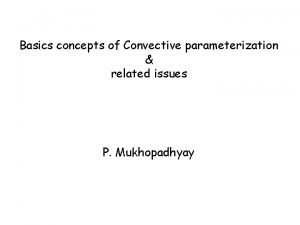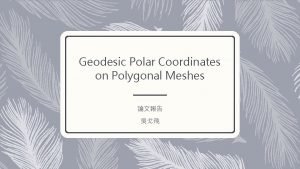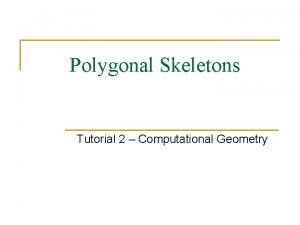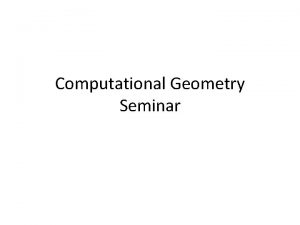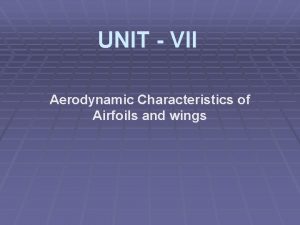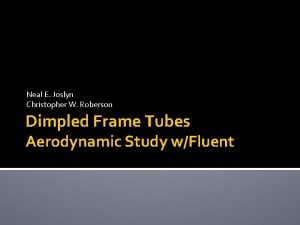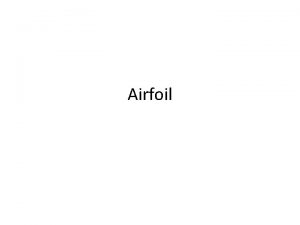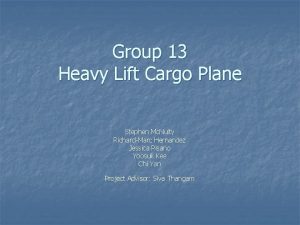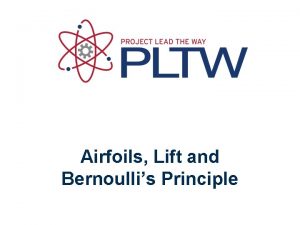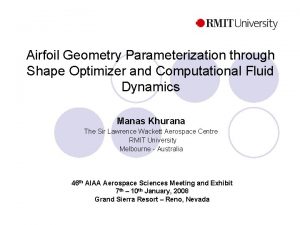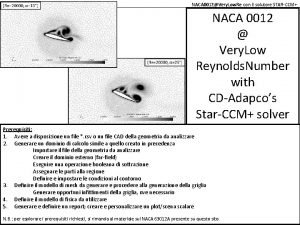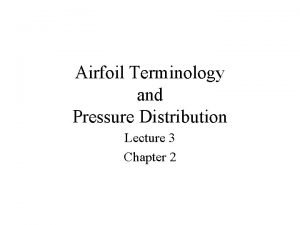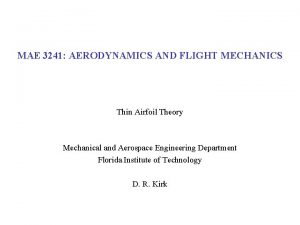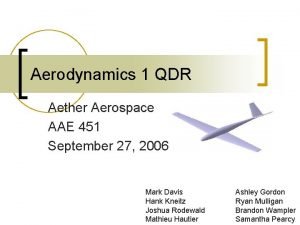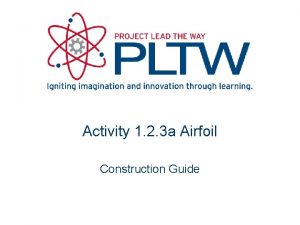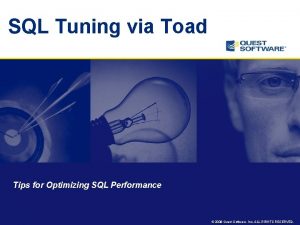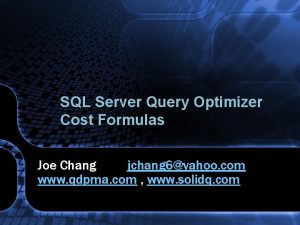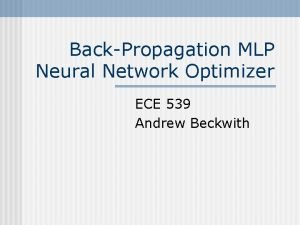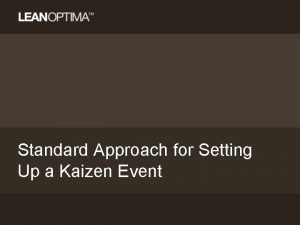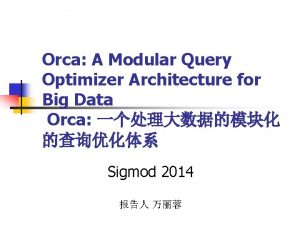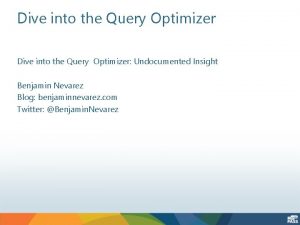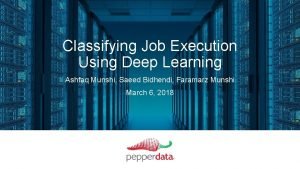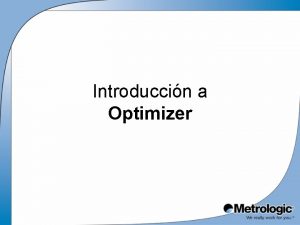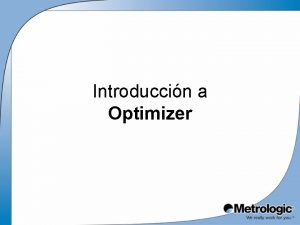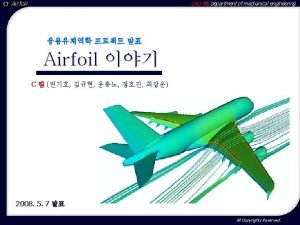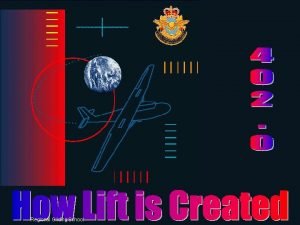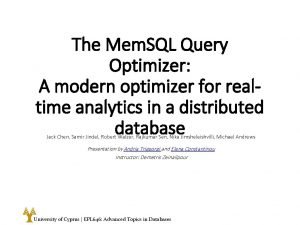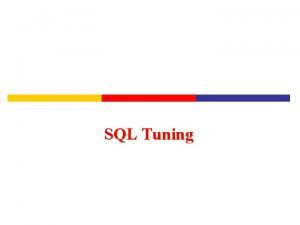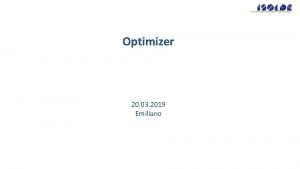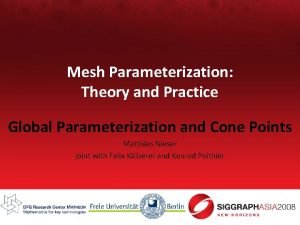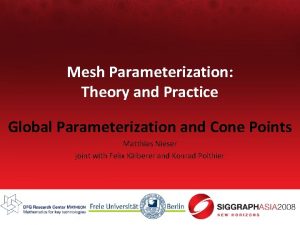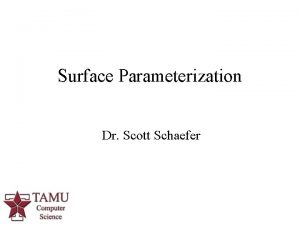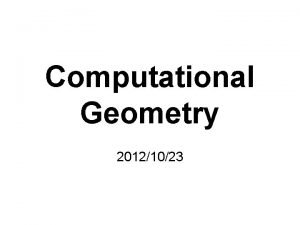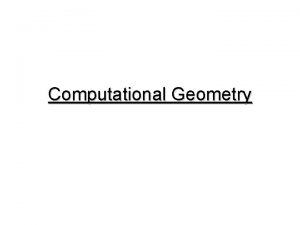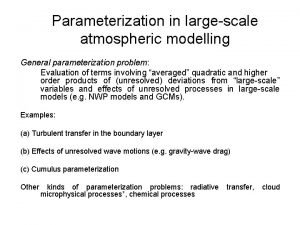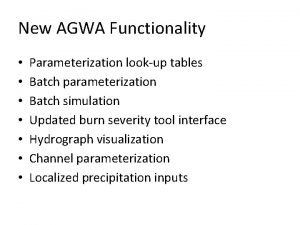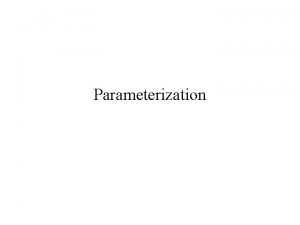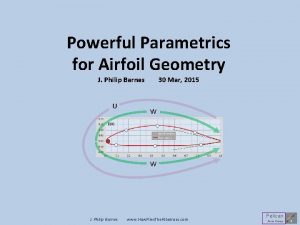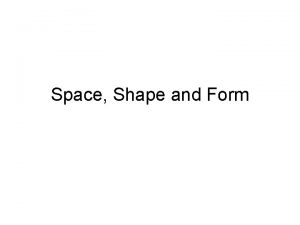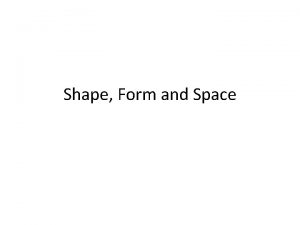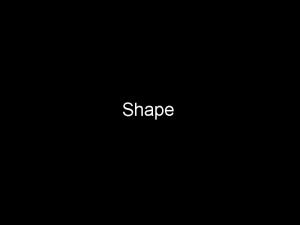Airfoil Geometry Parameterization through Shape Optimizer and Computational
























![Acknowledgements l Viscovery Software Gmb. H [http: //www. viscovery. net/] Mr. Bernhard Kuchinka Kindly Acknowledgements l Viscovery Software Gmb. H [http: //www. viscovery. net/] Mr. Bernhard Kuchinka Kindly](https://slidetodoc.com/presentation_image/38283c65efa581b4e329b8a9be509026/image-25.jpg)
- Slides: 25

Airfoil Geometry Parameterization through Shape Optimizer and Computational Fluid Dynamics Manas Khurana The Sir Lawrence Wackett Aerospace Centre RMIT University Melbourne - Australia 46 th AIAA Aerospace Sciences Meeting and Exhibit 7 th – 10 th January, 2008 Grand Sierra Resort – Reno, Nevada

Presentation Outline l Introduction Ø Role of UAVs Ø Research Motivation & Goals o Design of MM-UAV o Current Design Status I-view: www. defense-update. com l Direct Numerical Optimization Ø Airfoil Geometry Shape Parameterisation o Ø Flow Solver o Ø Test Methodology & Results Selection, Validation & Results Analysis Optimization o Airfoil Analysis l Summary / Conclusion l Questions www. airliners. net

Introduction l l Multi-Mission UAVs Ø Cost Effective; Ø Designed for Single Missions; Ø Critical Issues and Challenges; Ø Demand to Address a Broader Customer Base; Ø Multi Mission UAV is a Promising Solution; and Ø Provide Greater Mission Effectiveness X-45: www. Boeing. com Research Motivation & Goals Ø Project Goal - Design of a Multi-Mission UAV; and Ø Research Goal – Intelligent Airfoil Optimisation o Design Mission Segment Based Airfoil o Morphing Airfoils Pegasus: www. Northrop. Grumman. com RMIT University: Preliminary RC-MM-UAV Design Concept

Aerodynamic Optimisation l Design Methodology Ø Direct Numerical Optimisation o Geometrical Parameterization Model; and o Validation of Flow Solver Ø Coupling of the two Methods Ø Swarm Intelligence Optimization Ø Neural Networks Ø DNO Computationally Demanding; Ø Development of an ANN within DNO; and Ø Integrate Optimisation Algorithm within the ANN Architecture

Geometric Representation Technique Features l l Key Requirements Ø Flexibility and Accuracy; Ø Cover Wide Design Window with Few Variables; Ø Generate Smooth & Realistic Shapes; Ø Provide Independent Geometry Control; Ø Application of Constraints Optimization; and Ø Computationally Efficient for Shape Approaches Ø Discrete Approach; Ø Shape Transformations: Conformal Mapping; Ø Polynomial Representations; and Ø Shape Functions added to Base-Line Profile

Airfoil Shape Transformations l Conformal Mapping Approach Ø Ø l Computationally In-Expensive; Joukowski & Kármán-Trefftz Transformations; Transformation from Complex to -Plane; and Five Shape Parameters § xc - Thickness § yc - Camber towards leading edge § xt - Thickness towards trailing edge § yt - Camber towards trailing edge § n - Trailing edge angle Conformal Mapping Restrictions Ø Ø Ø Limited Design Window; Divergent Trailing Edge Airfoils possible; and Failure to Capture Optimal Solution not

Airfoil Shape Functions l Introduction Ø Ø Analytical Approach; Control over Design Variables; Cover Large Design Window; Linearly Added to a Baseline Shape; NACA 0015 Ø Ø Analytic Function Participating Coefficient act as Design Variables ( i); and Optimization Study to Evaluate Parameters Population & Shape Functions Optimization

Shape Function Convergence Criteria l l Convergence Measure Requirements Ø Flexibility & Accuracy; and Ø Library of Target Airfoils Geometrical Convergence Process Ø Specify Base & Target Airfoil; Ø Select Shape Function; Ø Model Upper & Lower Surfaces; Ø Design Variable Population Size (2: 10); Ø Perturbation of Design Variables; Ø Record Fitness - Geometrical Difference of Target and Approximated Section; Ø Aggregate of Total Fitness; and Ø Geometrical Fitness vs. Aerodynamic Performance

Intelligent Search Agent – Particle Swarm Optimization l Swarm Approach Ø Models Natural Flocks and Movement of Swarms; Ø Quick, Efficient Implementation; Ø Ideal for Non-Convex Discontinuous Problems; Ø Solution Governed by Position of Particle within N-dimensional Space; Ø Each Particle Fitness – pbest; and Records Simple Personal Ø Best Global Fitness – gbest; Ø Velocity & Position Updates based on Global Search Pattern; and Ø Convergence – Particles Unite at Common Location § 1. 2. 3. 4. Initialise Particle Swarm Initialise Particle Velocities Evaluate Fitness of Each Particle Update according to: i. Velocity Update ii. Position Update 5. Repeat until Convergence Satisfied J. Kennedy and R. Eberhart, "Particle Swarm Optimization“, presented at IEEE International Conference on Neural Networks, 1995. Algorithm

Particle Swarm Optimization Set Up l PSO Structure / Inputs Definition Ø Velocity Update: Ø Position Update: Particle Swarm Optimizer Search Agents Standard vs. Adaptive PSO Scaling Factors Cognitive & Social (c 1 & c 2) Ø ‘w’ Facilitates Local Search o c 1 = 2 o c 2 = 2 A-PSO Ø ‘w’ Facilitates Global Search o c 1 = 2 SPSO Inertia Weight (w): Determine ‘pull’ of pbest & gbest Ø c 1 – Personal Experience Ø c 2 – Swarm Experience where Maximum Velocity Ø 0. 1 -10% of NDIM o 0. 1 -10% of NDIM

Particle Swarm Optimizer - Function Test l Definition: l Search Domain: l Initialization Range: l Global Minima (Fitness): Low Velocity = Low Fitness Velocity Fitness

Particle Swarm Optimizer - Function Test l Definition: l Search Domain: l Initialization Range: l Global Minima (Fitness): Low Velocity = Low Fitness Velocity Fitness

Shape Parameterization Results l Summary of Results Ø Measure of Geometrical Difference Ø Hicks-Henne Most Favorable Ø Legendre Polynomials Computationally Not Viable Ø Aerodynamic Coefficients Convergence l Geometrical Convergence Plots / Animations Ø Ø l s s Hicks-Henne Geometrical Convergence Bernstein Geometrical Convergence Aerodynamic Convergence Plots / Animations Ø Ø s s Hicks-Henne Aerodynamic Convergence Bernstein Aerodynamic Convergence

Shape Functions Limitations l Polynomial Function Limitation Ø Ø l PARSEC Airfoils Local Shape Information; No Direct Geometry Relationship; NURBS Require Many Control Points; and Lead to Undulating Curves PARSEC Airfoil Representation Ø 6 th Order Polynomial; Fitness Magnitude of Shape Functions Ø Ø Ø Eleven Variables Equations Developed as a Function of Airfoil Geometry; and Direct Geometry Relationship H. Sobieczky, “Parametric Airfoil and Wings“, in: Notes on Numerical Fluid Mechanics, Vol. 68, pp. 71 -88, 1998

PARSEC Aerodynamic Convergence to Target Lift Curve Slope Convergence to Target Moment Convergence to Target Drag Polar Convergence to Target L/D

PARSEC Design Variables Definition Effect of YUP on PARSEC Airfoil Geometry YUP t/c Camber Nose Radius Low YUP = Good CD Performance Effect of YUP on PARSEC Airfoil Aerodynamics Lift Coefficient Drag Coefficient Moment Coefficient Lift-to-Drag Ratio

Shape Function Modifications l Airfoil Surface Bumps Ø Ø Ø l Aerodynamic Performance Improvements; Rough Airfoils Outperform Smooth Sections at Low Re; Control Flow Separation; Passive & Active Methods for Bypass Transition; Reduction in Turbulence Intensity; and Bumps Delay Separation Point Shape Functions - Further Developments Ø Ø Ø Ideal Surface Local Curvature Control; Roughness in Line with Boundary Layer Height; and Control over Non-Linear Flow Features Airfoil Surface Bumps to Assist Flow Reattachment Source: A. Santhanakrishnan and J. Jacob, “Effect of Regular Surface Perturbations on Flow Over an Airfoil”, - University of Kentucky, AIAA-2005 -5145 Bumpy Surface

Flow Solver – Computational Fluid Dynamics Laminar Turbulent

Flow Solver Validation – Case 1: NASA LS(1)0417 Mod l Validation Data Ø CP Agreement at AOA 10 ; Ø Lift & Drag Convergence over Linear AOA; Ø Lift 2% ; Drag 5%; Ø Solution Divergence at Stall; and Ø Fluid Separation Zone Effectively Captures Boundary Layer Transition

Flow Solver Validation – Case 2: NACA 0012 l Validation Data Ø CP Agreement at AOA 11 ; Ø Lift & Drag Convergence over Linear AOA; Ø Lift 5% ; Drag 7%; Ø Solution Divergence at Stall; and Ø Fluid Separation Zone Effectively Captures Boundary Layer Transition

Sample Optimization Run l Ø Ø Ø l Final Airfoil Shape Objective Function = CL = 0. 40 Minimize CD 2 Optimizer Inputs Final Solution ¡ Ø Ø Ø Ø Ø Swarm Size = r. LE = 0. 0368 YTE = 0. 0127 Teg = -19. 5 TEW = 29. 10 XUP = 0. 4581 YUP = 0. 0926 YXXU = -0. 2791 XL = 0. 5120 YL = 20 Particles [0. 001 , 0. 04] [-0. 02 , 0. 02] [-2. 0 , -25 ] [3. 0 , 40. 0 ] [0. 30 , 0. 60] [0. 07 , 0. 12] [-1. 0 , 0. 2] [0. 20 , 0. 60] [-0. 12 , -0. 07] Optimization History Plot

Aerodynamic Coefficient Database – Artificial Neural Networks l Artificial Neural Networks – Airfoil Training Database Ø Geometrical Inputs; Ø Aerodynamic Coefficient/s Output/s ; Set-up of Transfer Function within the Hidden Layer; and Output RMS Evaluation Ø Ø Coefficient of Lift NN Structure Coefficient of Drag NN Structure Coefficient of Moment NN Structure R. Greenman and K. Roth “Minimizing Computational Data Requirements for Multi-Element Airfoils Using Neural Networks“, in: Journal of Aircraft, Vol. 36, No. 5, pp. 777 -784 September-October 1999

Coupling of ANN & Swarm Algorithm

Conclusion l l l Geometry Parameterisation Method Ø Six Shape Functions Tested; Ø Particle Swarm Optimizer Validated / Utilized; Ø SOMs for Design Variable Definition; and Ø PARSEC Method for Shape Representation Flow Solver Ø RANS Solver with Structured C-Grid; Ø Transition Points Integrated; Ø Acceptable Solution Agreement; and Ø Transition Modeling and DES for High-Lift Flows Airfoil Optimization Ø Direct PSO Computationally Demanding; and Ø ANN to Reduce Computational Data www. mathworks. com www. cosmosmagazine. com
![Acknowledgements l Viscovery Software Gmb H http www viscovery net Mr Bernhard Kuchinka Kindly Acknowledgements l Viscovery Software Gmb. H [http: //www. viscovery. net/] Mr. Bernhard Kuchinka Kindly](https://slidetodoc.com/presentation_image/38283c65efa581b4e329b8a9be509026/image-25.jpg)
Acknowledgements l Viscovery Software Gmb. H [http: //www. viscovery. net/] Mr. Bernhard Kuchinka Kindly provided a trial copy of Viscovery SOMine
 Convective parameterization
Convective parameterization Geodesic polar coordinates
Geodesic polar coordinates Straight skeleton algorithm
Straight skeleton algorithm Computational geometry
Computational geometry Airfoil characteristics
Airfoil characteristics Kamm tail vs airfoil
Kamm tail vs airfoil Aerofoil shapes
Aerofoil shapes Pressure distribution airfoil
Pressure distribution airfoil Cargo plane airfoil
Cargo plane airfoil Bernoullis principle
Bernoullis principle Parsec airfoil
Parsec airfoil Airfoil naca 0012
Airfoil naca 0012 Airfoil terminology
Airfoil terminology Naca 4421
Naca 4421 Mh32 airfoil
Mh32 airfoil Airfoil construction
Airfoil construction Electron geometry and molecular geometry
Electron geometry and molecular geometry Frog sql
Frog sql Inside the sql server query optimizer
Inside the sql server query optimizer Mlp optimizer
Mlp optimizer Kaizen optimizer
Kaizen optimizer Runzheimer logistics optimizer
Runzheimer logistics optimizer Orca model
Orca model Inside the sql server query optimizer
Inside the sql server query optimizer Display campaign optimizer
Display campaign optimizer Pepperdata capacity optimizer
Pepperdata capacity optimizer
